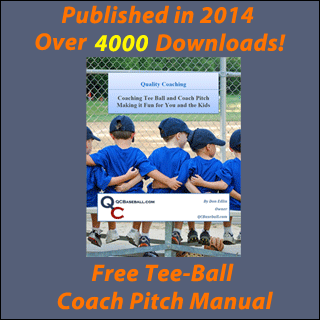Baserunning: Tagging Up
Running on Third - Leading Off
Get the signs from your coach while you are standing on the base. This is more critical than at any other base because your back is toward the pitcher. Once you have received the signs, take your lead. The biggest difference in taking your primary lead from third base rather than from first base is your need to stay clear in foul territory. You don't want any question if you are hit by a batted ball, you are in foul territory. Another difference is the pitcher may be pitching from the stretch or from the windup position. It's easier to be more aggressive in your secondary lead if the pitcher is pitching from the windup; regardless, the goal of the secondary lead is to get your momentum moving toward home plate to maximize your jump on a batted ball. Make sure you don't move into fair territory when taking your secondary lead. Strive to have your right foot hit the ground as the ball is entering the hitting zone. Always watch the ball all the way from the pitchers hand to the plate. The trajectory of the pitch will give you a good indication of what might happen.
Another important point when taking your secondary lead is to make sure you keep your hips and shoulders square to the field so you can easily continue towards home or get back to third quickly if necessary. A good catcher who sees the shoulders squared towards him will make a throw to third. This position therefore will not only cause the runner to be slower getting back to third, but will encourage more throws from the catcher.
Running on Third - Getting Back
Once the ball has entered the hitting zone, it will either be hit, fouled off, get by the catcher, or be caught by the catcher. If the catcher catches the ball, have your weight on your right side. Push off your right foot and crossover back towards third base and fair territory. Even though you took your lead in foul territory, you want to return to the bag in fair territory. The reason is if the catcher is going to attempt to pick you off, he has to throw the ball accurately to the inside of the bag. This makes it more difficult for the third baseman to make a quick tag and it may result in a bad throw that either hits you or ends up in left field. Whatever the end result, you have placed more pressure on the catcher by returning in fair territory.
Any ball hit in the air, you should start back towards third base. The general rule of freezing on a line drive doesn't apply at third. If it's a line drive that gets through the infield, you'll score easily even if you start back towards third. If it's a fly ball, then you need to return to third to tag up.
Running on Third - Ground Ball
Knowing when to run home on a ground ball with 0 or 1 outs is very difficult. The depth of the shortstop and second baseman will let you know if they are willing to give up a run for the out or not. If they are deep you should be able to score on any ground ball hit to them. Most third base coaches will let you know what to do depending on the situation, he may tell you to hold if it's hit to the pitcher or third baseman and run if it's hit anywhere else. Even if those instructions are given, you must still read the play and determine what you will do.

Related Baseball Drills
Shallow Fly Balls
Team Cut-offs
Runner on Second
It's always nice to get a runner to third base with less than two outs because of the ability to score a run from there without having to get a hit. So it might be worth the risk to try and get him to third base on a fly ball that will result in the first out. Coaches love to score runs without the aid of a base hit and getting a runner to third with less than two outs increases the chances of scoring that runner. With a runner on second and one out, there is less to gain by tagging up and getting to third and therefore not worth the same risk. In this situation you want to be sure the player can make it to third. The last thing you want is a runner being thrown out at third for the third out. With two outs he's already in scoring position at second and it's most likely going to take a base hit to get him home. So there's not much reason to risk being thrown out at third. Now in youth baseball where errors and passed balls can result in a number of runs, you'll have to weigh those options depending on the game.
It makes sense to be careful when trying to advance to third on a fly ball, but what can be difficult is the decision on whether to tag up or not. On a ball hit to the outfield that is not caught, the runner who is tagging up at second may only be able to make it to third instead of scoring on the play. If the runner is confident the outfielder is going to catch the ball (routine play), and he can make it easily to third, then tag up. Otherwise he should come off the bag and increase the distance from the bag as he gains confidence that the outfielder cannot catch the ball. These are judgments made by runner and can be difficult decisions. There are situations where a runner will be off the bag and will have to return to second when the catch is made and other times where a runner will be held at third instead of scoring because he was tagging and the ball was not caught. As a coach try to realize that these situations can be some of the most difficult for players to learn and get a knack for.
Right field vs. left field
One fact to keep in mind is the difference in throwing distance to third base from right field vs. left field. The throw from right field is much longer and makes tagging up and getting to third base much easier than the same type of fly ball being hit to left field.
Runner on First
In most cases the runner on first will not tag up on a fly ball. The throw from the outfield to second base is the shortest throw from most of the outfield and leaves little chance for a runner to advance from first successfully. On a ball hit deep to the outfield the possibility for advancing is much better, but the possibility of things going wrong outweigh the benefit of taking the extra base. Having the batter rounding first base while a runner is tagging up at the same base is never a good thing. In addition a ball that is dropped by the outfield could actually be picked up quickly and a force out made at second. Finally the runner may only be able to advance to second or third on a ball he normally might be able to score on. The hitter is also held up as he can't advance until he is sure the runner will be moving on to the next base. In youth baseball you may want to make it easy on the players by telling them to never tag up at first base unless the ball is foul. As they get older there will be situations where you will want them to tag up. Runners on first and third is a good example where you might want the runner at first to tag up. In this case having both players break on the catch and reading the throw can provide an opportunity for at least one of them to advance.
Most Recent Blog Posts
Working With Players on Focusing on the Correct Part of the Baseball when Hitting (October 15 2016)
Getting More Accurate Throws From Your Team (April 5 2016)
I found your website by "googling" for a baseball website to give me some advice about helping my grandson with basic skills. I have been reading with great interest until my eyes get "bleary". Good stuff. Really good stuff. You are providing the kind of advice I was looking for and you do a very thorough job of it. Keep up the great work.
A big fan,
- Stephen B.







